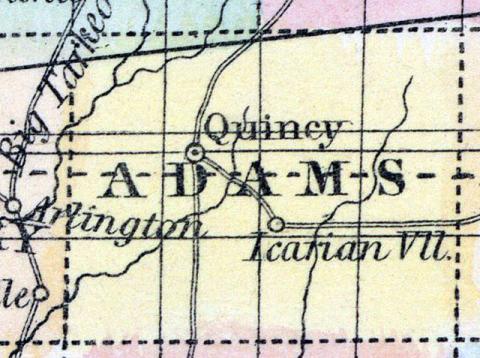ADAMS, a county in the S. W. part of Iowa, has an area of 432 square miles. It is intersected by the Nodaway river, which flows south-westward, and also drained by several of its head streams. This county is not included in the census of 1850, and the county seat is not yet located. (Baldwin's New and Complete Gazetteer of the United States..., 1854)
ADAMS COUNTY was settled in 1851, by Messrs. Walter, Bowman and Toar, from Nodaway Co., Mo. The first election held, was in April, 1853, at which twelve votes were cast. Quincy, the county-seat of Adams, was located in April, 1853, by Commissioners appointed by the Legislature. The first sale of lots took place in September, 1853. The present population of the County, (Feb. 1855), is about 700; the number of votes 150. The last State census showed a population of 342, making an increase of over one hundred per cent, during the past eight months, and the gain will far exceed that the coming twelve months.
But one church — the Methodist Episcopal — has a substantial frame meeting-house, 24 by 30. Other societies will organize during the season.
The district schools, (under the common school law), are the only educational institutions yet in the County. These are susceptible of improvement.
Probably no county in Iowa possesses more motive power for machinery than Adams. Two saw-mills already in operation, and two others being built, and yet not one-twentieth of the demand is supplied.
One or two grist or flouring-mills are very much needed — also a carding and fulling-mill. There are plenty of good mill-seats on the Nodaway to be had for Congress price, ($1.25 per acre). The very nature of the soil and climate — the high rolling prairies, interspersed with streams of pure water, as well as the experience of those already engaged in the business, points out this as one of the best sheep-growing countries in the world. The day is not far distant when that business will be carried on largely in Western Iowa.
The richness, fertility, and depth of the soil in Adams County, will compare favourably with any county in Western Iowa, and as to timber, it is better supplied than those surrounding it. The principal streams are the West, Middle, and East Nodaway rivers. The heads of the One-hundred-and-two, one branch of the Little Platte, and the East and Main, or Middle Nodaways, extend from north to south across the County. Veins of stone-coal 2-1/2 to 3-1/2 feet thick have been found along the Middle Nodaway.
The climate of Western Iowa is peculiar; the winters are very dry, no rain falling usually from October till March and April. There is not generally much snow, and the ground in the winter is frozen to a great depth, owing to the loose nature of the soil. Three winters' experience in Iowa, and I have never seen the frost leave the ground after winter sets in, until spring. Our streets and roads are dry and dusty. The months of August and September are usually very dry, most of our rains coming during the earlier part of the season. It has been frequently remarked, that no soil in the world would stand as much dry weather as this, and there is none that is less injured by continued wet weather. Owing to these peculiarities of the climate, no section of country can compare with this for stock raising, the cold but dry winters being just the thing for cattle and sheep. (Iowa As It Is in 1855; A Gazetteer for Citizens..., 1855)
Annotations
Total Population 1860
1533
Free Black Population 1860
0
Presidential Election Result 1856
Republican
Presidential Election Result 1860
Republican
Presidential Election Result 1864
Unconditional Union (1864)
Latitude
41.021656
Longitude
-94.696906
Type
County
County
Adams
State
Iowa

